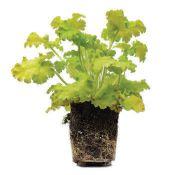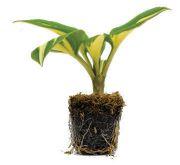
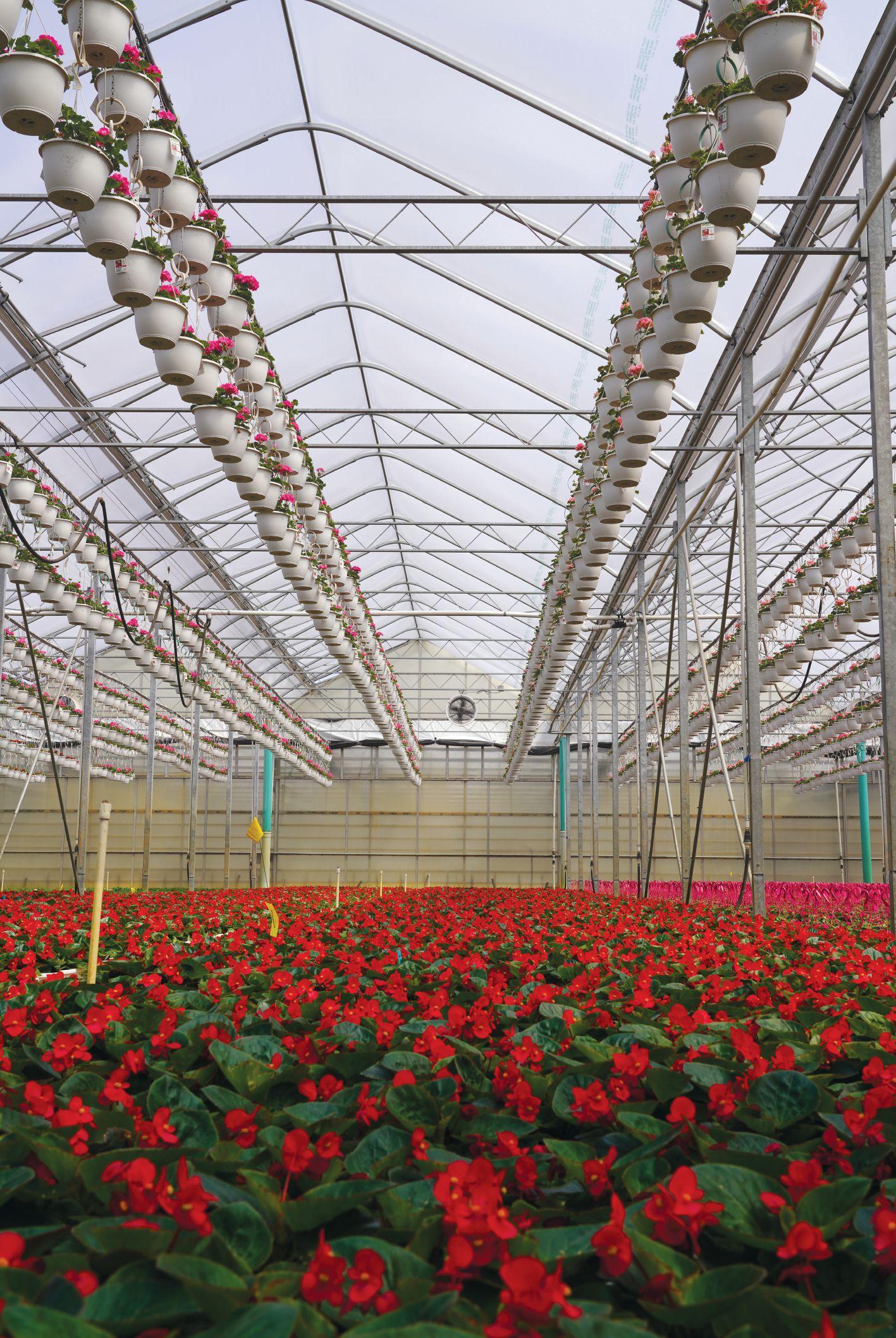



Green
in
On the cover: An Aphidius wasp parasite stinging an aphid. Read more about hosting biocontrol agents in the greenhouse on Page 14. (Source: Getty Images)
BY DR. KEN FRY
BY MELHEM SAWAYA
BY
AMY KOUNIAKIS







Green
in
On the cover: An Aphidius wasp parasite stinging an aphid. Read more about hosting biocontrol agents in the greenhouse on Page 14. (Source: Getty Images)
BY DR. KEN FRY
BY MELHEM SAWAYA
BY
AMY KOUNIAKIS

A few months back, Greenhouse Canada was honoured to take part in the 2024 Green Industry Show and Conference in Red Deer, Alberta. This year, our hosts, Landscape Alberta and the Alberta Greenhouse Growers Association (AGGA), outdid themselves in organizing a truly welcoming and engaging show.
On Page 28 of this issue, we get into greater details about this year’s event, but I’d like to take this space here to thank our gracious hosts for organizing this opportunity to connect, reconnect and celebrate the industry. It was just my second time at the GISC, and just like my first time in 2023, I was moved by the spirit of community that permeates the show. Alberta’s greenhouse growers are a tight-knit and incredibly welcoming group dedicated to the advancement of the industry across Canada.
guide for the industry. We’ve run several articles over this time to share their research as it unfolded and this piece, located on Page 8, is an encompassing article which summarizes a lot of their work and offers some actionable advice on managing light emissions with curtains.
Just as we celebrate the industry tradition that is the GISC in this issue, we also wrap up our coverage of another important event for Canada’s horticulture sector: the 2024 Sawaya Garden Trials. Show-runner Melhem Sawaya highlights another 22 cultivars (of the more than 3,000 trialled at his greenhouse), and shares his impressions and some of the lessons he’s learned throughout the 2024 trial season. Check it out on Page 20 and maybe find some inspiration for next year’s season.
Much inspiration was to be found at this year’s event. In fact, one of this month’s articles was inspired by Olds College instructor, Dr. Ken Fry’s, presentation on managing aphids in the greenhouse. I don’t want to go into too much detail here, but his insights on pest and beneficial biology and their responses to their environment was fascinating and, I think, very important for growers who want to be a good host to their biocontrol agents to know. Read more from Dr. Fry on Page 14.
Another feature in this month’s issue, offers advice on how greenhouse growers can manage nighttime light emissions. Dr. Fadi Al-Daoud and a host of his colleagues have been working for years to develop this handy
Our Inside View columnist, Gary Jones rounds out this issue by encouraging the sector to come together to pool our pest management strategies to determine their effectiveness and discern best practices. He points out that this is something done regularly in other parts of the world but not to the same extent in Canada. He challenges readers to consider the possibilities and how it can be carried out. Read more on Page 34.
“Alberta’s growers are a tight-knit and incredibly welcoming group.”
And finally, don’t forget to mark your calendars for Grower Day 2025 (June 17th) where we will mark 30th anniversary of this intimate industry event. We’re looking forward to hosting an event that honours the past and will help usher in a future full of opportunity. I hope to see you there!


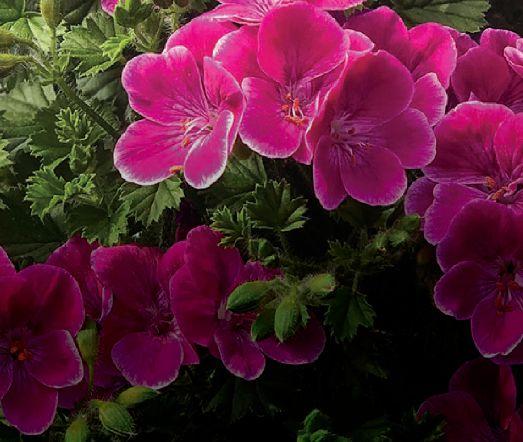
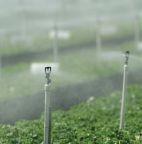
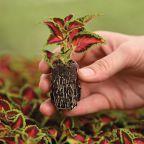
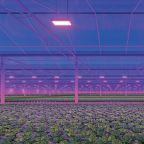





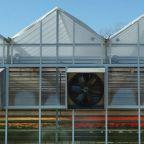

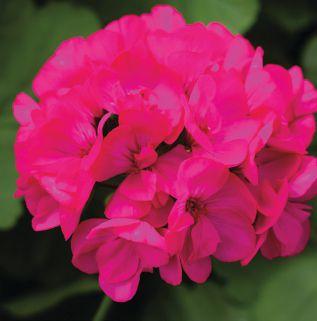


Ontario Greenhouse Vegetable Growers (OGVG) have appointed Matt Marchand as their new public affairs and policy analyst.
In a recent release, OGVG announced the new appointment and that Marchand will be providing insights and recommendations to help shape public policies at all levels of government. Marchand’s role will ensure OGVG is engaged with policy makers, stakeholders and the public to share the contributions of the greenhouse vegetable sector.
Marchand holds a Masters of Economics and Political Science from the London School of Economics and
Political Science. His previous roles include president and CEO of the Windsor-Essex Regional Chamber of Commerce and, most recently, he’s worked as a consultant for IG Wealth Management.
“I am very pleased that Matt has decided to join our team and provide his extensive experience and proven track record in business, government, and community relations,” said Richard Lee, OGVG executive director.
“His strategic vision and dedication to excellence will undoubtedly contribute to the continued growth and success of our organization.”
(Source: OGVG)

BCfresh has appointed Steve Roosdahl as its next CEO.
In a recent release, the grower-owned and operated company announced the new leadership of Roosdahl, effective January 2,2025.
Roosdahl will succeed Murray Driediger, who will retire March 31 after directing the organization since 2007.
Roosdahl joins the company with nearly 30 years of experience in the international fresh produce industry, including a 29year career at The Oppenheimer Group, where he most recently served as vice president
Up to $300,000 in funds are being allotted towards the Agriculture Labour Sub-Program in partnership with Sustainable Canadian Agricultural Partnership (Sustainable CAP), Agriculture and Agri-Food Canada and PEI Department of Agriculture.
In a recent release, the government of Prince Edward Island (PEI) announced the program stream that will provide farmers and agricultural organizations access to funding for a variety of initiatives focused on improving the workforce, including recruitment, workforce training and professional development opportunities and more.
“I am pleased to be continuing our efforts to support and build the workforce in our Agriculture industry,” Bloyce Thompson, PEI Deputy Premier and Minister of Agriculture, said in the release.
(Source: Government of Prince Edward Island)
of operations and food safety.
“I am honoured to join BCfresh and build upon the strong foundation Murray and the team have established,” said Roosdahl, in the release.
“The company’s commitment to its grower-owners and focus on sustainable
local agriculture align perfectly with my vision for the future of produce. I see tremendous opportunities to leverage technology and innovation while staying true to the core values and deep agricultural roots that define BCfresh.”
(Source: BC Fresh)
Source: Statistics Canada, Labour Force Survey, December 2024
0.2% the rate by which employment rose since
January 2023.
2.5% the amount by which youth employment fell in 2024.
3.8% the rate by which average hourly wages increased on a year-overyear basis.
Greenhouses provide ideal conditions for thriving crops but also attract a variety of pests. From tiny insects to rodents, managing these intruders poses a significant challenge.
While crop-focused pest control often gets the most attention, Structural Pest Management (SPM) is equally important in ensuring a greenhouse’s productivity and longevity. By addressing pests such as rodents, flies, crawling insects, and cockroaches, SPM serves as a protective barrier, safeguarding the facility from threats to plant health and compliance with safety standards. Here’s how growers can implement effective strategies:
Fortify the Perimeter
Exterior bait stations and covered snap traps along greenhouse walls are your first line of defense. Keep the critters out before they even think about sneaking in.
Layered Protection Inside
Mechanical traps in hallways, packhouses, and mechanical rooms catch anything that makes it past your outer defenses. Regular check-ins keep these traps ready for action.
Inspections
Regular inspections can uncover weak spots like holes, broken screens, or missing door sweeps. Clearing trash, and debris eliminates pest invitations.
Arthropod Control
Spiders, flies, cockroaches, and beetles—these arthropods are some of the uninvited guests no grower wants. Integrated Pest Management (IPM) is your go-to strategy for keeping them out.
• Create a No-Go Zone
Clear a buffer zone around the greenhouse. No plants, no debris, no hiding places—simple but effective.

• Seal Every Crack Arthropods are crafty and can slip through the smallest gaps. Sealing entry points keeps them out for good.
• Light Traps
Light traps and coloured glue boards work wonders inside greenhouses to reduce pest pressure.
Organic Growers
Organic greenhouses can rely on mechanical controls and advanced IPM tools instead of pesticides.
• Track the Trouble
Advanced systems like trap mapping and barcoding help pinpoint pest activity, enabling growers to address issues early.
• Stay Audit-Ready
Modern pest programs offer digital portals with e-binders, pest trend reports, and pesticide usage records. These tools simplify audits and ensure your greenhouse remains transparent and compliant.
Greenhouse pest management goes beyond controlling pests—it’s about meeting strict industry standards like HACCP, Canada GAP, and organic certifications. With over a century of expertise, Abell Pest Control customizes programs to keep growers audit-ready and operating efficiently.

Excerpts from OMAFA’s guide to managing greenhouse nighttime light emissions
BY DR. FADI AL-DAOUD, Ontario Ministry Of Agriculture, Food and Agribusiness (OMAFA)
An increase in the use of supplemental lighting in greenhouses has been accompanied by an increase in the amount of light emitted from greenhouses at night mostly during autumn and winter months. Without proper management strategies, light emitted from greenhouses during nighttime hours can potentially be disruptive to neighbours. The following Best Management Practices (BMP) recommendations and insights are based on a multi-year project launched in 2020 to understand greenhouse light emissions and the effect of light abatement curtains on the greenhouse environment and crops.
KEY RESEARCH FINDINGS:
• Nighttime light emissions from greenhouses depend on the intensity of the light fixtures, the level of vegetation in the greenhouse and closure of light abatement curtains.
• The effect of greenhouse light emissions on skyglow is variable depending on several factors such as location, moon elevation and cloudiness levels.
• Greenhouse light abatement curtains cause
ABOVE
fluctuation in humidity levels and air and plant temperatures.
• Long-photoperiod, low-intensity light recipes may reduce fluctuations in the greenhouse environment under light abatement curtains.
Light abatement curtains are beneficial for reducing nighttime light emissions when supplemental lighting is used in greenhouses. They also have the added benefit of increasing energy efficiency by reducing heat loss to the outside environment. Alongside the benefits of light abatement curtains, there may be some impacts on the growing environment, such as fluctuations in temperature and humidity which can impact crop physiology. These impacts can be managed by:
• Gapping ceiling light abatement curtains to ventilate the greenhouse and maintain ideal growing conditions.
• Employing a long-photoperiod low-intensity lighting strategy to reduce fluctuations in the growing environment under light abatement curtains.
Supplemental lighting in greenhouses has led to an increase in light emissions at night. Curtains, when deployed strategically, are an effective way to control these emissions and save time and money.
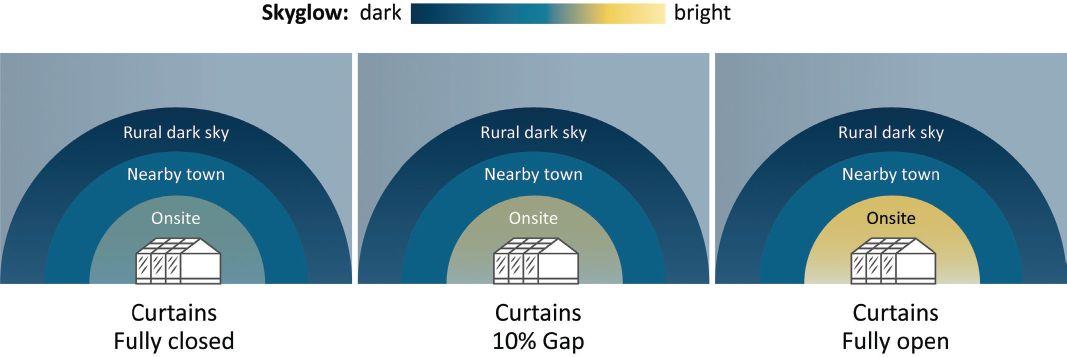
FIGURE 2
Depiction of average sky brightness (skyglow) measured from an upward facing car-mounted sky quality meter (SQM) light sensor, with greenhouse light abatement curtains at 0%, 10%, and 100% open, compared to the average measured for rural dark sky and/or nearby town. No significant changes were observed in sky brightness of rural dark sky or nearby town in any scenario.
• Lighting before sunrise (2:00 a.m. to 6:00 p.m.) rather than after sunset (8:00 a.m. to midnight) to reduce the amount of time light abatement curtains are used and allow producers to manage the greenhouse environment more easily.
BMP #1: Gapping ceiling light abatement curtains to ventilate the greenhouse and maintain ideal growing conditions. This is the most common way that producers manage the increase in temperature and humidity that is observed
24_014613_Greenhouse_Canada_FEB_CN
in some greenhouses by allowing the heat and water vapour to escape. This strategy, however, also reduces energy efficiency by allowing other elements of the growing environment to escape. Gapping light abatement curtains up to 10% may not cause significant increases in light emissions or skyglow. (Figure 2)
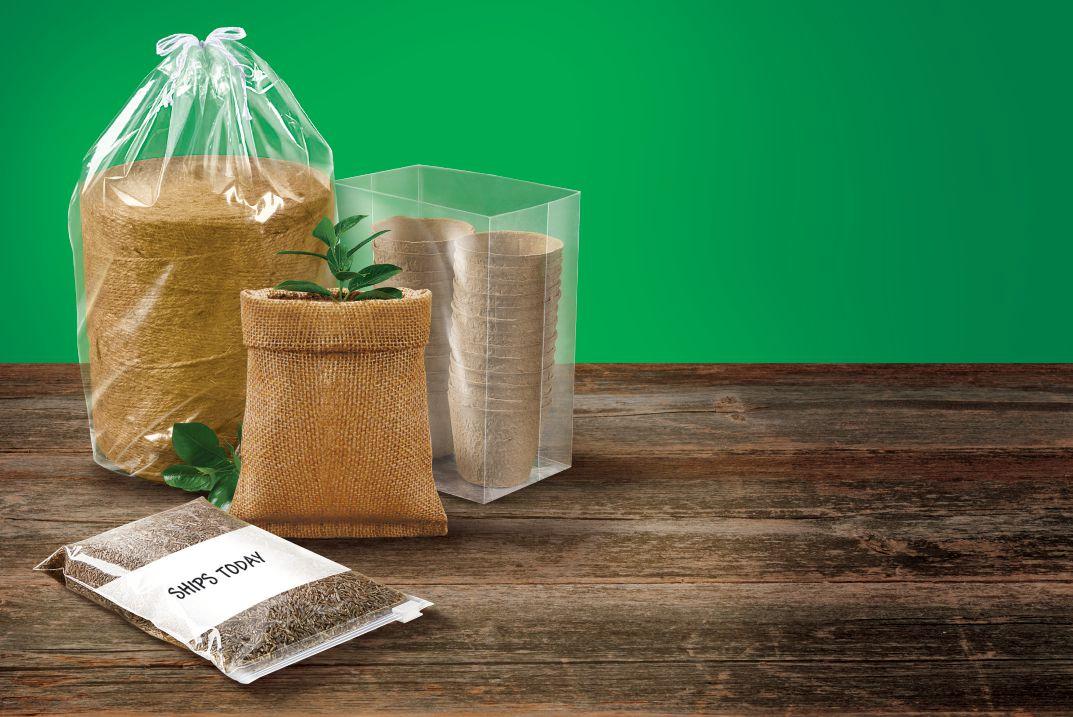
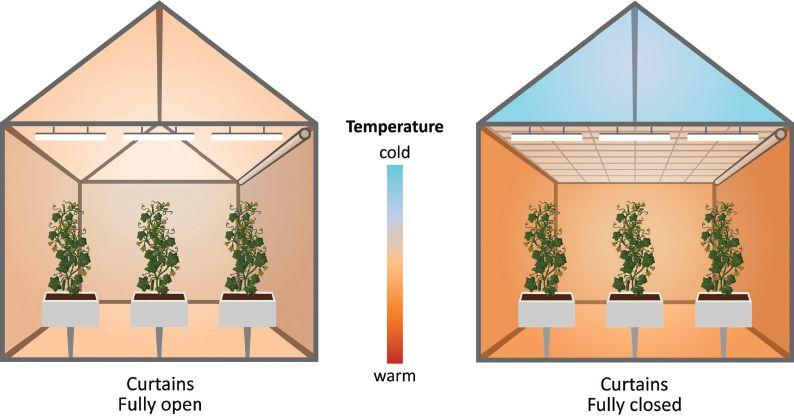
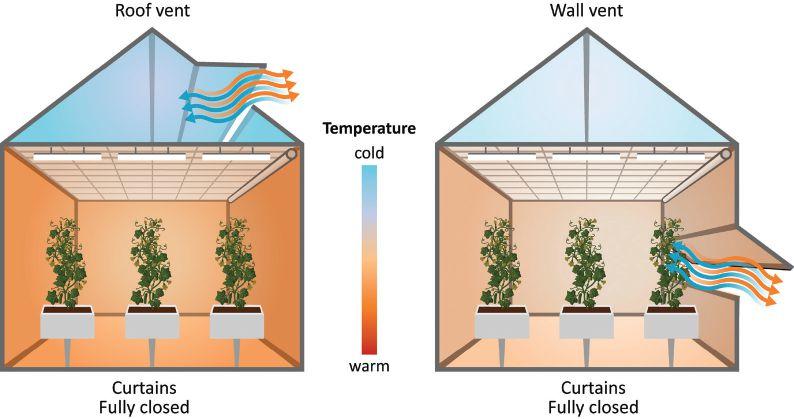
3
Depiction of the effect of (Top row) an open and closed ceiling light abatement curtain and (Bottom) roof and wall vents, on air temperature in the attic above the curtain and in the growing area below the curtain.
Maintaining consistent growing conditions throughout the greenhouse, horizontally and vertically, is important for optimal production. The location of air vents in the greenhouse and the amount of gapping in the ceiling curtains will impact the degree and nature of air temperature stratification. Experience suggests that gapping of curtains to different degrees allows for more air circulation between attic and growing area and reduces air stratification. Researchers at the University
of Guelph conducted a case study using air temperature data from a commercial vegetable greenhouse in southwestern Ontario (Figure 3) which showed stratification of air temperature developed when the curtains were fully closed. At night, warmer air was present in the growing area and cooler air was present in the attic. The temperature of the air in the attic and the growing area converged when the curtains were fully opened.
To investigate the effects of light abatement curtains on
The increase in air and plant temperatures under LED lights and light abatement curtains was accompanied by higher relative humidity, whereas under HPS lights and light abatement curtains there was a drop in relative humidity levels (Figure 4).
BMP #2: Employing a longphotoperiod low-intensity lighting strategy to reduce fluctuations in the growing environment under light abatement curtains. By using lower intensity lighting and longer photoperiods, producers can reduce the temperature and humidity fluctuations allowing for easier management of the greenhouse environment under light abatement curtains.
Between December 2022 and May 2023, another experiment was conducted in Harrow, where two mini greenhouses with LED lights and light abatement curtains used different lighting strategies:
1. Typical 16-hour lighting strategy (2:00 a.m.–6:00 p.m. with 250 μmol/m2/ sec).
greenhouse relative humidity, air temperatures and plant temperatures, researchers at Agriculture and Agri-Food Canada’s Harrow Research and Development Centre (Harrow) used four mini greenhouses (50 m2 each) outfitted with light abatement curtains to grow tomatoes in the winter of 2021/2022 (December 2021–April 2022).
Increases in air and plant temperatures were observed under both HPS and LED lights when light abatement curtains were closed.
2. Long photoperiod (24 hour) low-intensity lighting strategy (2:00 a.m.– 6:00 p.m. with 200 μmol/m2/sec and 6:00 p.m.–2:00 a.m. with 100 μmol/m2/sec).
The daily light integral (DLI) in both mini greenhouses was equal (14.4 mol/m2/day), and the light abatement curtains were fully closed between sunset and sunrise for both lighting treatments. There were fluctuations in air temperature under both treatments between warmer daytime temperatures and colder nighttime temperatures, but the fluctuations under the longer photoperiod low-intensity lighting strategy were less

Depiction of air and plant temperatures, and relative humidity levels in experimental mini greenhouses with and without light abatement curtains under HPS and LED lights.
pronounced during some days (Figure 5). Although the yield of the tomato plants grown in both greenhouses were similar, the longer photoperiod low-intensity growing strategy required less light fixtures thereby saving money for greenhouse producers.
BMP #3: Lighting before sunrise (2:00 a.m. to 6:00 p.m.) rather than after sunset (8:00 a.m. to midnight) to reduce the amount of time light abatement curtains are used and allow producers to manage the greenhouse
environment more easily.
Producers can take advantage of changes in sunrise and sunset times in autumn and winter months to reduce the amount of time that light abatement curtains are used. This also allows the producer to manage the greenhouse environment more easily, because temperatures outside the greenhouse are lower before sunrise than after sunset.
Researchers in Harrow found that using supplemental lighting before sunrise reduced the amount of time that light abatement curtains would be used in each month. The biggest difference was observed in December when using supplemental lighting before sunrise resulted in light abatement curtains being closed 1 hour and 25 minutes less than using supplemental lighting after sunset (Figure 6). When the researchers looked at the outside temperature for
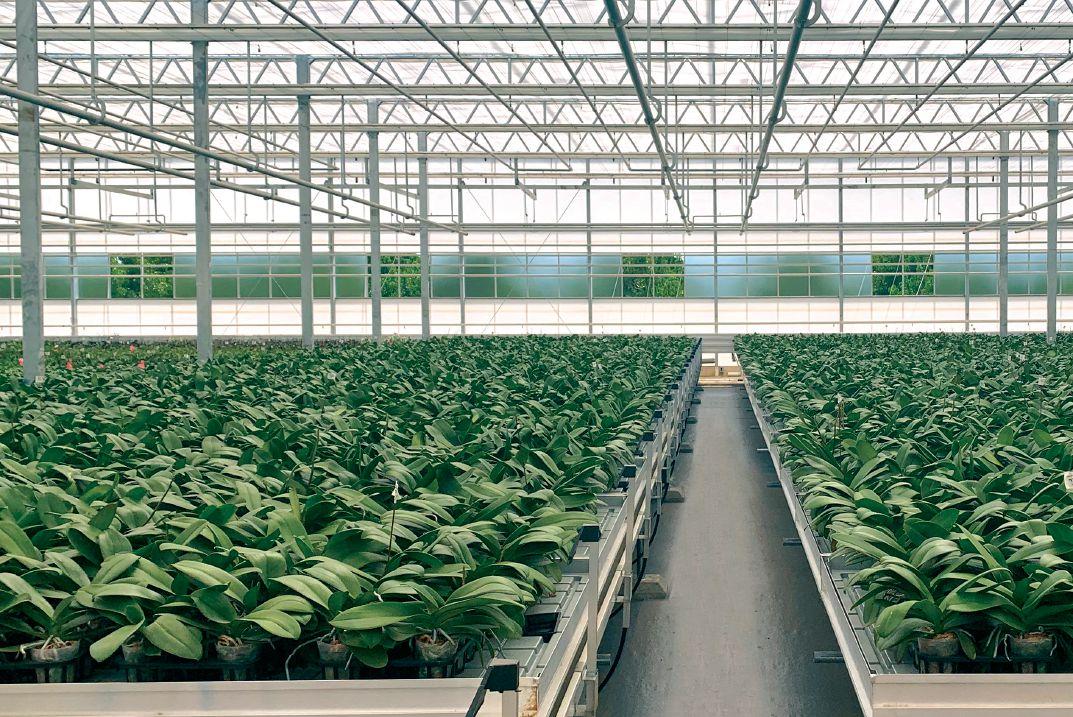
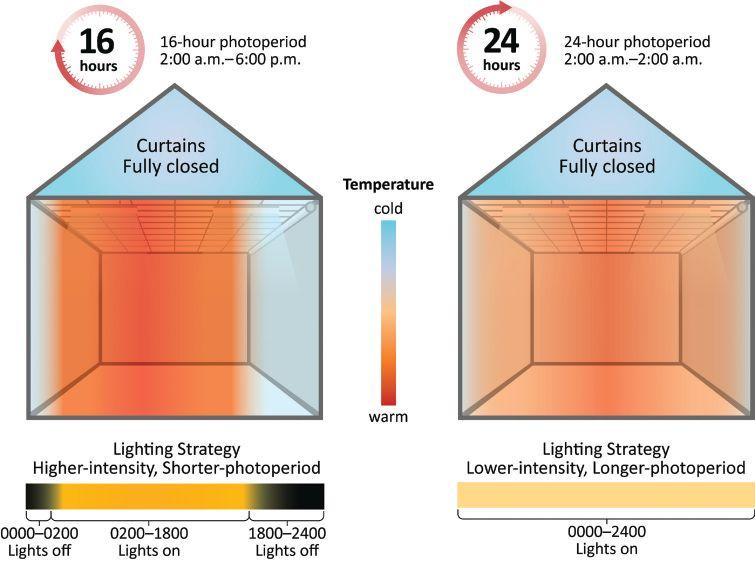
Depiction of air temperature fluctuations with time in experimental mini-greenhouses using a conventional 16-hour higher-intensity lighting recipe or a 24-hour lower-intensity lighting recipe under light abatement curtains. Less air temperature fluctuations over time with the 24-hour lighting strategy is ideal.
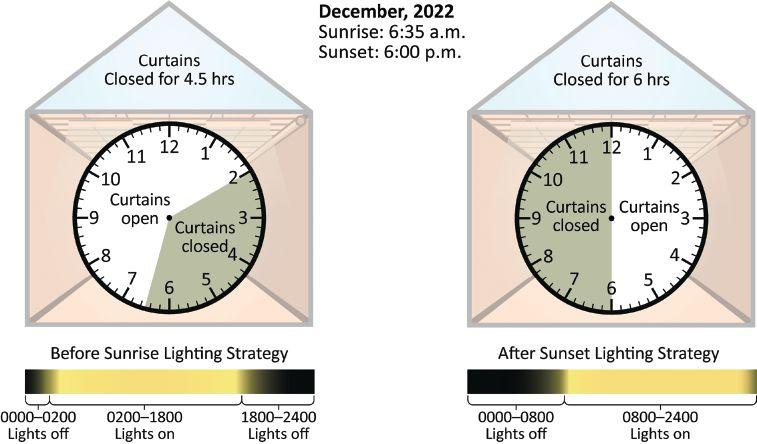
FIGURE 6
Depiction of the amount of time light abatement curtains would have to be closed in December, 2022, using “before sunrise” and “after sunset” lighting strategies.
the same period of time under the two lighting scenarios, it was found that there was a greater difference in temperature between the greenhouse environment (assumed to be 21°C) and the temperature outside the greenhouse before sunrise as compared to after sunset. This temperature gradient suggests it would be easier for producers to reduce the heat buildup in their greenhouses under light abatement curtains if they use supplemental lighting before sunrise rather than after sunset. This would allow producers to manage the greenhouse environment more easily.
Other technologies that may also help producers maintain a consistent environment under light abatement curtains include through-curtain fans. Through-curtain fans are typically installed in the growing area below the ceiling curtains with a duct leading through the curtain to the attic space. They blend air from above and below the light abatement curtains when curtains are fully closed. Cooler air from the attic is pulled into the fan where it is mixed with warmer air from the growing space to achieve the desired temperature before the mixed air is blown back into the growing space. The use of this technology in Ontario greenhouses is currently being studied.
Dehumidification technologies may also provide additional climate control in the greenhouse and energy savings in the autumn and winter months or when outside ventilation is limited by curtain closure. However, the use of dehumidification technology needs to be tested in greenhouses with light abatement curtains.
This research was funded by OMAFA and Ontario Greenhouse Vegetable Growers (OGVG).
Visit here to view and download OMAFA’s BMP: Managing greenhouse nighttime light emissions document in its entirety in English or French.
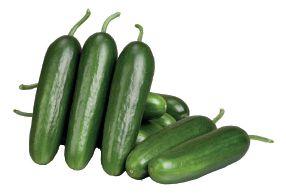




CUCUMBER SPECIALIST

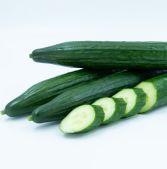
Dutch cucumber, mid- early, strong, dark green leaves. Single fruit, shiny dark green color, veined, 32-35 cm. Cultivation late autumn and winter seasons in greenhouse. Resistance: HR: CGMMV / IR: CYSDV, CVYV.


Dutch, early, mid-strong, productive. Single fruit, shiny dark green color, veined, 30-32 cm. Cultivation autumn, winter and spring seasons in greenhouse. Resistance: HR: CGMMV / IR: CYSDV, CVYV.
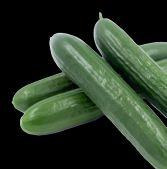

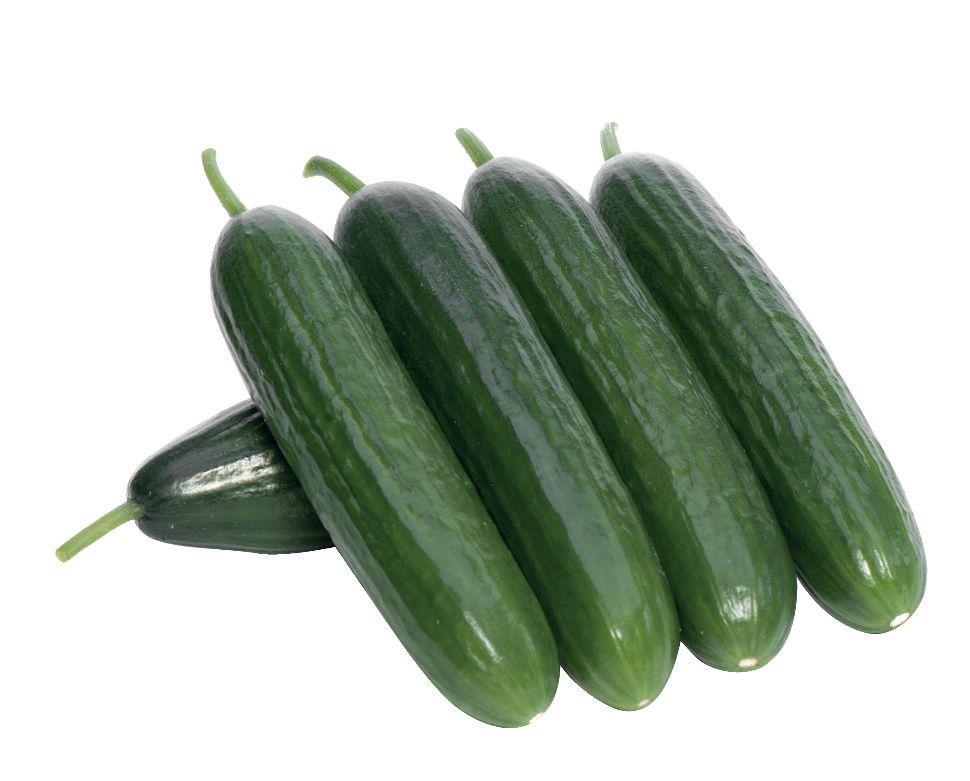
Dutch cucumber, strong, dark green leaves. Single fruit, shiny dark green color, intensive veined, 32-35 cm. Cultivation late autumn and winter seasons in greenhouse. Resistance: HR: CGMMV / IR: CYSDV, CVYV.


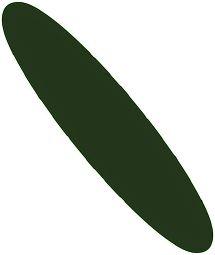
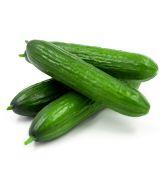

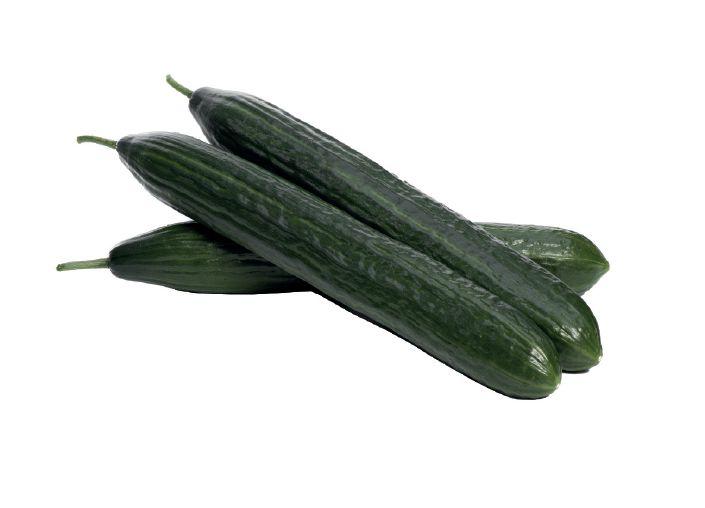


Beit Alpha cucumber, strong plant, productive lateral shoots, big size leaves, short internodes, early. Green color, slightly veined, 14-16 cm, multi setting, high quality. Cultivation Autumn and spring seasons in greenhouse. Resistance: IR: CVYV, CYSDV, ZYMV, CMV, CGMMV, Px.

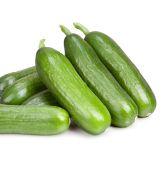

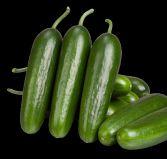
Baby mini-snack cucumber, compact plant, short internodes, small size leaves, early. Dark green color, 6-8 cm, multi setting, productive. Cultivation Autumn and spring seasons in greenhouse.

Baby snack cucumber, compact plant, short internodes, small size leaves, early. Green color, 7-9 cm, multi setting, tasty. Cultivation Autumn and spring seasons in greenhouse. Resistance: IR: CVYV, CMV
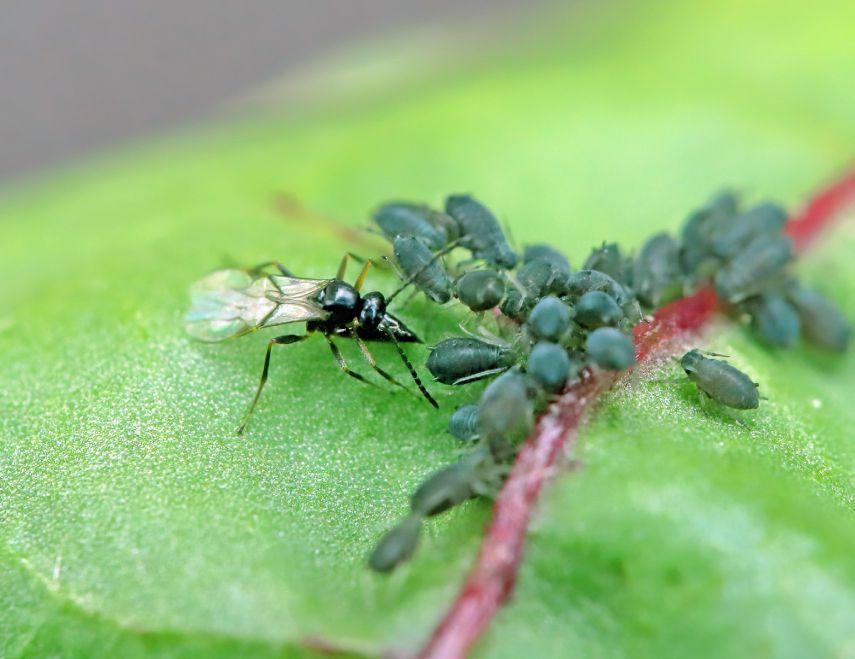
Aphids, small soft-bodied insects in the Order Hemiptera, Family Aphididae, are common pests in the greenhouse and garden. There are approximately 1,350 species of aphids in North America and 5,000 species worldwide. Thankfully, only a handful of species are considered routine pests in horticultural crops.
BY DR. KEN FRY Horticulture Instructor, Olds College
Aphids use their piercing/sucking mouthparts to suck up phloem sap. The feeding wound can reduce the aesthetic appeal of a plant due to the formation of lesions at the feeding site. The amount of phloem sap removed can stunt the growth of the plant. The primarily liquid diet of aphids results
ABOVE
in their producing large volumes of liquid waste called honeydew. The honeydew can serve as a food source for fungi and bacteria, leading to increased plant disease. The piercing/ sucking method of feeding is also very effective for transmitting various plant pathogens, especially viruses. Aphid populations increase rapidly due to their habit of producing live young without the need to mate. This form of reproduction is called parthenogenesis. In addition to not having to find a mate and finding a suitable place to lay their eggs, parthenogenesis can result in what is called telescoping of generations where the young are born with embryos
Roll out the red carpet for beneficial predators, like the Aphidius colemani pictured above parasitizing young black bean aphids (Aphis fabae), and get the most out of these greenhouse allies.

Aphid Species
Green Peach Aphid, Myzus persicae
Melon Aphid, Aphis gossypii
Foxglove Aphid, Aulacorthum solani
Potato Aphid, Macrosiphum euphorbiae
TABLE 1
Aphid Identifying Features
Green colour, green cornicles, converging antennal tubercles
Black to green colour, black cornicles, diverging antennal tubercles
Green colour, darker green patches around the base of the cornicles, dark patches at the “knees” and “socks”, elaborate antennal tubercles
Green to pink colour, a long cauda (structure at the tip of the abdomen), long cornicles
Host Species Preferences of Aphid Parasitoid Wasps
already developing inside of them.
Given suitably warm conditions and abundant food, an aphid can go from being born to giving birth within as short a period of time as four days. It is little wonder their populations can go from a few unseen females to hundreds or thousands in a couple of weeks.
With so many species of aphids and their propensity to occur in large numbers, it is no surprise that a host of predators, parasitoids and pathogens have adapted to use aphids as a food source. We can exploit this relationship by enlisting the help of these beneficial organisms to manage aphid populations in our crops.
The most commonly used and arguably the most effective biological control agents (BCAs) are parasitoids. In the case of aphid biocontrol, these are a group of small wasps that specialize on one or a few species of aphid. The wasp will locate a patch of aphids and lay a single egg in or beneath each aphid (Fig. 1). Most aphid parasitoids will lay up to 100 eggs in their lifetime
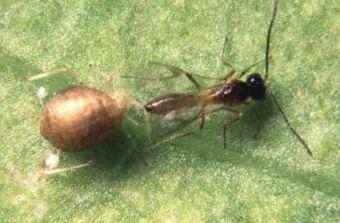
with most of the eggs deposited within the first two-to-three days of emergence from the pupa. The eggs may be laid in one area if the host population is high or they can flit about searching for hosts wherever they can find them, resulting in the tracking of aphid populations through the greenhouse. It is important to note that a sugar or nectar source is available for the newly emerged adult wasps. This can be accomplished by having a few flowering plants in a vegetable crop or a pre-flowering ornamental crop.
The wasp eggs will hatch inside the host aphid and the larval wasp will consume the entire contents of the aphid (Fig. 2). Once the wasp has consumed the aphid, it will pupate inside the aphid. Once development is complete the emerging adult will cut a smooth circular hole in the posterior of the aphid and emerge to find new hosts to lay eggs. The mummified body and smooth round exit hole are evidence the wasps are hard at work for you. If you see jagged holes, these are made by another species of wasp that parasitizes the parasitoid. This is called hyperparasitism. The aphid host is killed but the hyperparasitoid that emerges will only seek out already parasitized aphids to reproduce. This will reduce the effectiveness of Aphidius or Aphelinus. You may have to abandon the parasitoids in favour of predators if this happens.
Some instances of parasitoid egg laying will be defeated by the immune system of the aphid and some parasitized aphids may be consumed by predators, hence the need to release a sufficient amount of wasps. The wasp population will usually not cycle within a greenhouse resulting in the need to make multiple releases to ensure there
Parasitoid
Aphidius colemani
Aphidius matricariae
Aphidius colemani (not as effective as it is against the Green Peach Aphid, therefore increase release rates)
Aphidius ervi
Aphelinus abdominalis
Aphidius ervi
Aphelinus abdominalis

FIGURE 2
A Green Peach Aphid parasitized by Aphidus colemani. Note the wasp larva curled up inside the host aphid.
are parasitoids present throughout the cropping period and to compensate for losses in the system due to the immune response, predation and the inevitable mortality of the wasps themselves. For ornamental crops where appearances count, parasitized aphids, or mummies, can bring down the value of the plant. Therefore, parasitoids should be released preventatively as they are not effective at reducing high populations. Instead, they are best at maintaining a low population, usually low enough that the few mummies that are present will not reduce the aesthetic value of the plants.
When releasing parasitoids, you may witness an increase in winged aphids a few days to a week after release. The aphids may respond to being parasitized by releasing an alarm pheromone that alerts their neighbours of a threat. Adult females can respond to this threat by altering subsequent offspring such that they will have wings as adults. This allows the aphids to disperse away from the threat. The result for the producer is they see more
aphids on their sticky cards and think it means the aphid population is much higher than it actually is. Another consequence is the aphids will spread more quickly as a result of the release of the parasitoids. The take-home lesson from this biological feature is that while you may initially release the parasitoids in hot spots, it is advisable to follow up with more widely distributed releases.
One substantial and important aspect of using parasitoids for the management of aphids is to recognize that each species of parasitoid will parasitize only one or a select few species of aphids. Therefore, it is important to accurately identify the species of aphid you have and match the appropriate species of parasitoid (Table 1).
To maximize the effectiveness of the releases, pre-expose the wasps to the species you have in your crop. This can be achieved by placing infested leaves near the release point or releasing in hot spots where there are many aphids. As with the next BCA we will encounter, Aphidoletes aphidimyza, parasitoids benefit from an absence of wind or rain. Whenever possible turn down or turn off the circulation fans and overhead misting systems to provide a window of opportunity for the wasps to search for hosts and disperse.
Banker plants are another method to release Aphidius colemani. You can order banker plants from commercial suppliers or prepare your own. The banker plant is usually comprised of a pot with oats, barley or rye that is infested with the Bird Cherry Oat Aphid, Rhopalosiphum padi. This aphid is parasitized by Aphidius colemani. The aphid feeds only on grasses so this banker plant system is appropriate for vegetable operations. The aphids reproduce on the grass only and do not infest vegetable crops. Aphidius will reproduce on the aphid and emerging adults will disperse out into your crop. Banker plant systems should be prepared at least two weeks prior to the crop being established. This will allow adequate time for the wasps to develop and begin to explore the greenhouse. Banker plant systems can last for two-to-three months. Be sure to water the plants and not allow any pesticides to be applied.
Aphidoletes aphidimyza is a small midge in the Order Diptera, Family Cecidomyiidae. These flies are effective at seeking out populations of aphids to lay from 50-200 eggs in their short lifetime. The larvae
(Fig. 3) hatch out and feed on the aphids. Unlike parasitoids, these predators do not alarm the aphids so the aphids are unlikely to produce more winged offspring or to disperse. Repeated releases are required due to the predatory larval stage being only a short period in the entire life cycle of the fly. The flies require a moist substrate to pupate in. If this is not available (e.g. plastic on the floors) then the frequency of releases needs to be increased as the fly population will not cycle or increase on its own. When releasing the flies, which often

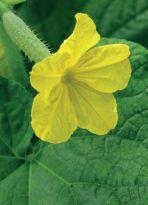
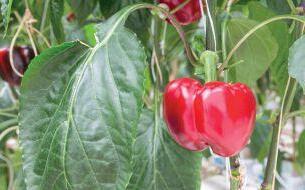

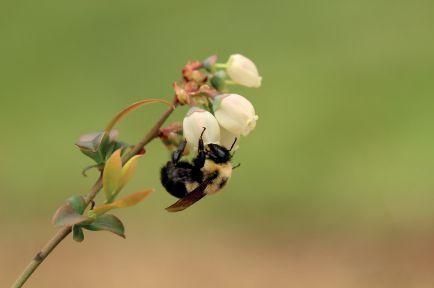
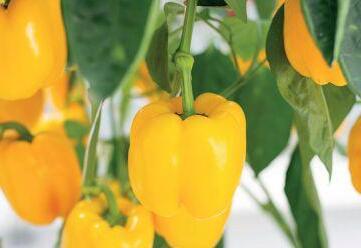
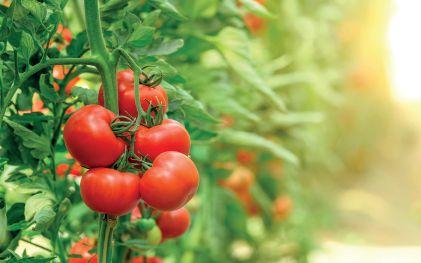


A Syrphid larva amongst parasitized and unparasitized aphids. Note: can you spot the orange Aphidoletes larva as well?
come packed as pupae in a substrate, ensure the package is kept in the shade. The adults fly at dawn and dusk so reduce or turn off ventilation fans during this time to allow the adults to seek out the aphids in the crop. One drawback of this predator is that it undergoes diapause in low light conditions (less than 12 hours of

variegatus). The larvae of both types and the adults of the Brown Lacewings are voracious predators of aphids. The larvae do not disperse well so it is important to release this predator directly where aphids are. Larvae are the easiest form to distribute, with no lag time between release and effect. They are also available in egg form and as adults, although these are not as easy to use. While these predators usually do not cycle well in the greenhouse you may see evidence of reproduction by observing their characteristic
Another common predator of aphids and one that has recently become available commercially are flower flies in the Order Diptera, Family Syrphidae. There are many species of flower fly in North America and if you do not have screens on your vents, it is highly likely that native species will fly in on their own in search of aphids. There is now a commercially available species, Eupeodes . Flower fly adults require pollen and nectar for food can be used for flower flies. Eggs are laid near aphids and the large green larvae hatch out to feed on nearby aphids (Fig. 5). The larvae will pupate on the undersides of leaves so no moist substrate is necessary for


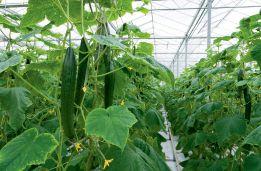



Biological Control Agents can be effective for managing a wide range of pests, including the ever-difficult aphids. Not all BCAs are resistant to pesticides so it is best to rely on preventative releases before you can detect the pests. This should result in a manageable pest population without the use of pesticides. However, should the pest population get out of hand, curative releases (high release rates in a higher number of localities) will be required or in extreme cases resorting to pesticide applications. If pesticides are applied, wait several days or weeks before releasing BCAs again as the residues with have a greater impact on them than the pests.
BCAs are living organisms and as such need to be treated with care. When they arrive do not store them in the cooler and keep them in the shade. They should be released upon arrival for best results and survival. If storage is required be certain to consult the packaging for the recommended temperature and humidity.
With attention to which BCAs to use, how to receive and then release them and being consistent with preventative and maintenance releases you should have successful pest management



BY MELHEM SAWAYA
This is a continuation of our coverage of the 2024 Sawaya Garden Trials, held in Waterford, Ontario.
The Sawaya Garden Trails, now in its 24th year, evaluates the hardiness of both annuals and perennials for the Canadian marketplace.
Every cultivar from the trial has been scored out of 10 from a grower point of view and consumer point of view, which produced two average numbers: one to reflect production and performance and the other for consumer appeal.
For the sake of the limited amount of information that we can publish, the following article highlights just a few cultivars that performed exceptionally through the whole season. It should be noted that, in total, 80 per cent of the cultivars we trialled graded above 8 out of 10 from the production and the customer appeal. Here are some more highlights from the trial with their score and some insight into their performance.
1. Begonia Beauvilia Red 9(grower POV)/10(consumer POV) 9/10
2. Begonia Waterfall Bicolour 9/9
These are two samples of the boliviensis begonias that have vigorous growth which make them excellent garden performers. Beauvilia red and

waterfall bicolour were a highlight of the trials, which needed no deadheading or shaping, but they got better as the season went along even through a season of very heavy rain fall where the blooms are very vibrant within an hour of rain stopping. They are excellent in hanging baskets and the right combinations. It takes full sun and heat just like all the other begonias.
3. Begonia x benariensis BIG Pink Green Leaf 9/9
This fibrous begonia gives a great garden show from planting in May to frost. Big begonia is one of the begonias that is most consumer friendly where it does not require much watering at the same time too much water is not a problem if the media its planted in has good drainage. We water all the varieties in our trials the same way and they thrive just as good as the petunias next to them. Excellent in landscape and combinations.
4. Begonia x interspecific Stone hedge Light Pink Bronze Leaf 10/10
This begonia is extremely vigorous but strong enough to stay upright after a rain. Stone hedge grows fast and naturally branches. Great in large containers or gallons for landscape. Consumer education to how vigorous is needed.
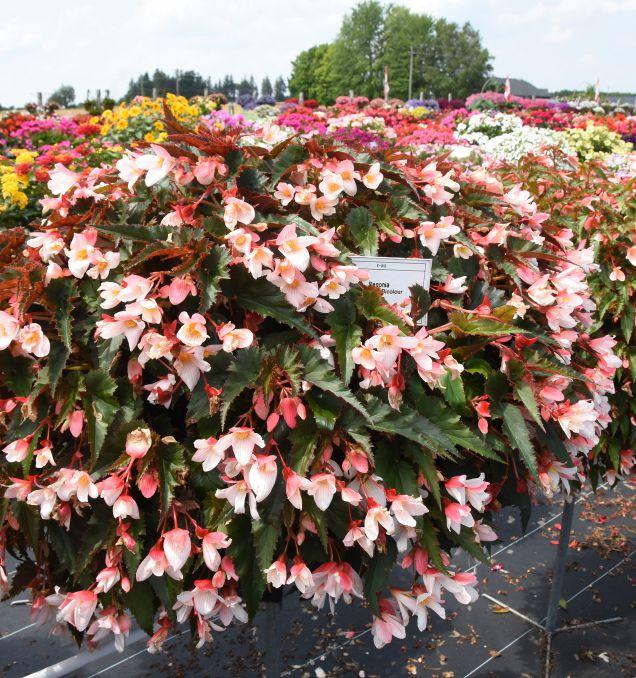
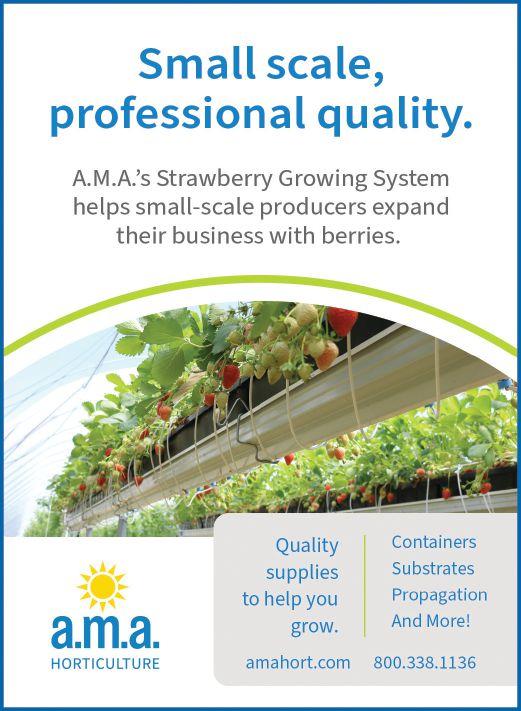












































































Dutch contemporary design Most efficient LED fixtures








Superior light distribution with high efficacy




















Compact & robust dimming solution to optimize yield








































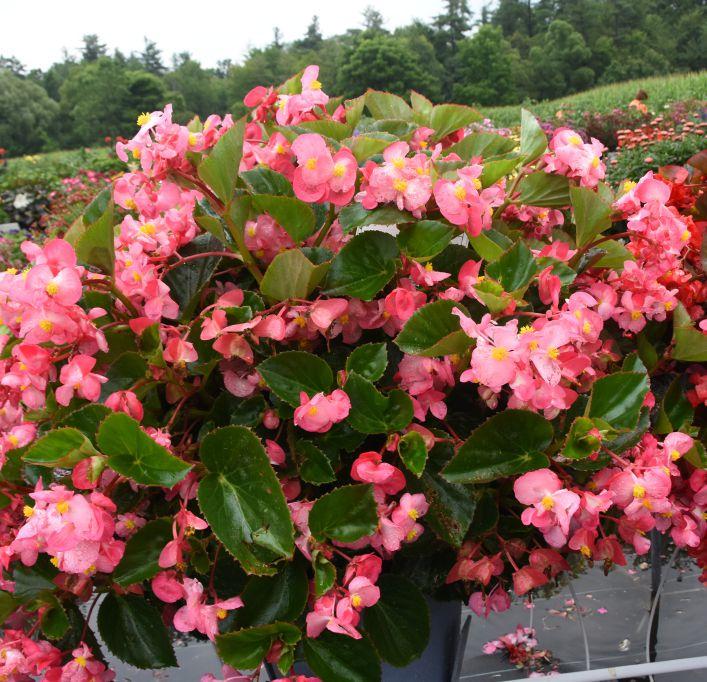
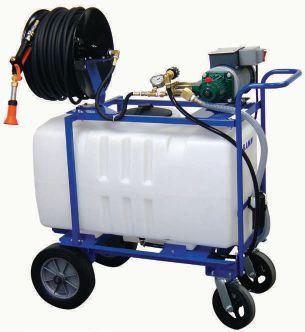





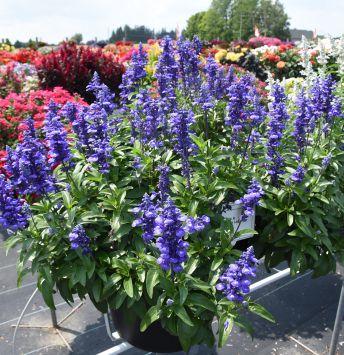
5. Salvia farinacea Sally fun Blue Lagoon 9/9
This variety has a medium growth habit compared to other blue salvias blooms all the way through the summer, branches very well and great pollinators. Sally fun salvia can be used as a centre in combinations or landscape for a magnificent view the whole summer.
6. Angelonia Serena Blue 9/10
This is a seed Angelonia that spends more energy in branching rather than growing tall which gives a full pot look, loaded with blooms that never need to dead head or growth regulated. It’s a cost-effective beauty that rivals or may be better than any vegetative series. Like other Angelonia, Serena Blue loves the heat and rain never diminishes its beauty.
7. Helichrysum Fancifillers Silver star 9/9
This is the Helichrysum that does not take over the combination but enhances the look of any flower combination. Self branching and grows well after it is established.
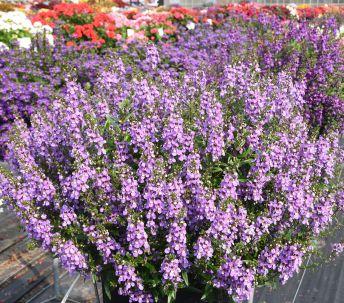

8. Plectranthus Fancifillers
Guacamole 8/8
The two-tone leaves are colourful without any flowers. These could be used in planters or hanging baskets without any other flower combination. Strong but not overpowering growth habit. Could grow in shade areas but the sun intensifies the two-tone leaf colour.
9. Bracteantha Granvia Peachy
Keen 10/10
This is the plant with ageless flowers, where you would have three or four generations (Flushes) of flowers, and all look great. Excellent performance the whole summer and gets better in the fall. Terrific addition to summer and fall production. Grow it as one rooted cutting in 10” but give it 12 wks. It will end up with better plant without splitting.
10. Gerbera Endless Robin 8/7
This is a true garden gerbera that put on fresh flowers the whole summer with no sign of powdery mildew, with strong flower stems. Excellent in pots and landscape and as a centre in combinations.
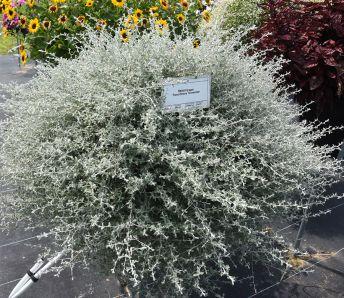

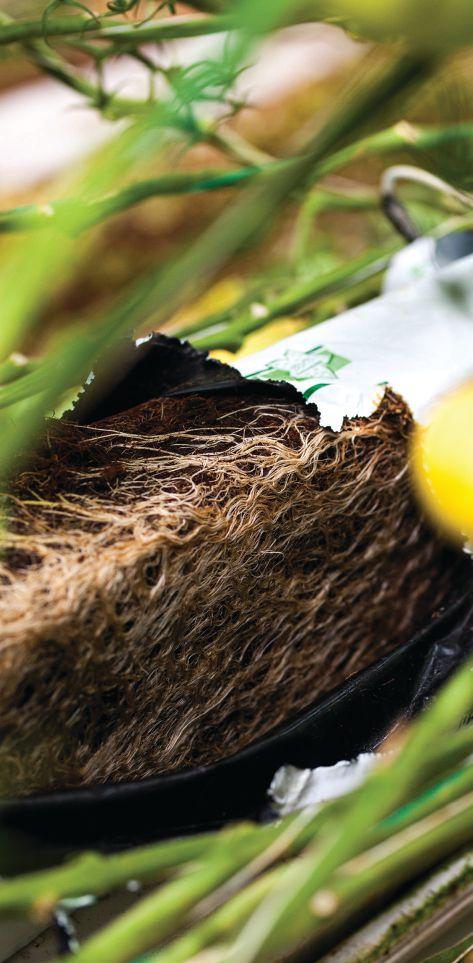


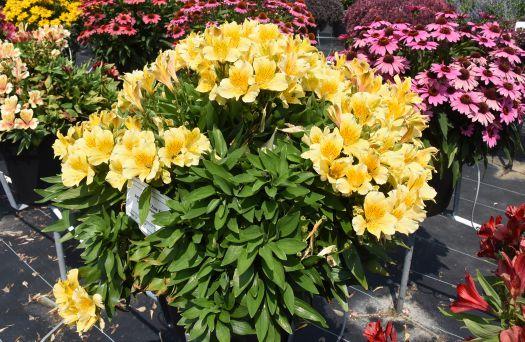
11. Alstromeria Inticancha Havana 9/9











This is another trial highlight that customers pick first when we do the charity sale after the trials. A perennial for our area evaluated for the last two years and it’s gotten bigger every year. It puts on a great show of flowers the whole season till frost. This is a top landscape item.
12. Echinacea Sunmagic Vintage Electric Orange 10/10
This is a very floriferous perennial where the blooms last the whole summer. Rain does not negatively affect the Sumagic vintage electric orange Echinacea. It’s a pollinator magnet and excellent in any landscape.
13. Echinacea Artisan Red Ombre 9/9
This is a compact perennial that flowers the first year, and



features large, single flowers that open deep red then they soften up as they age. Another pollinator favourite that is excellent for small gardens that flowers all summer into the fall.
14. Rudbeckia Sunbeckia Graffiti Scarlet 9/9
This is not a perennial for zones 7 through 10, but we use it as annual for our area (zone 5) because of the unparalleled beauty of its large flowers. This cultivar has to grow in full sun to get strong stems for the large flowers. It’s beautiful in large pots and in the landscape.
15. Echinacea Sombrero Adobe Orange 8/8
This cultivar has an intense orange flower that makes other Echinacea pale in comparison. Its dark-green foliage, even with spent flowers, still looks great in the fall and its seed is a source of food for birds.


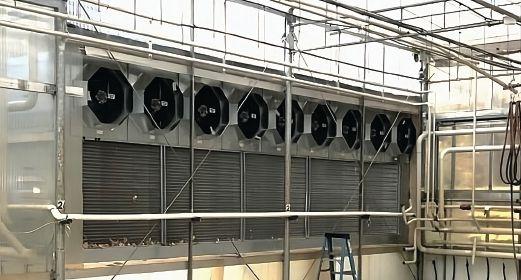

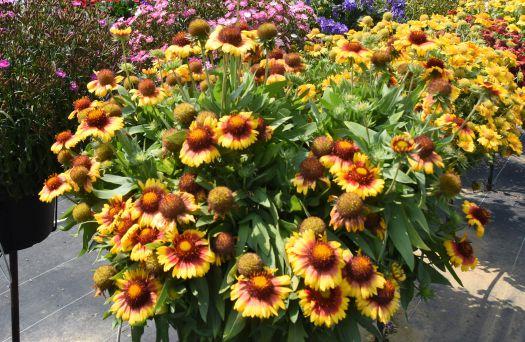
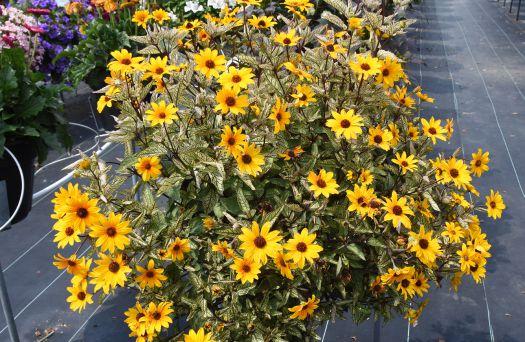
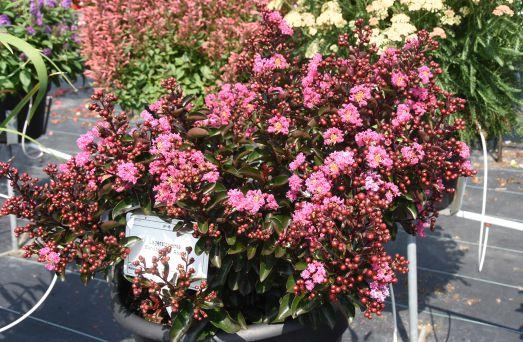

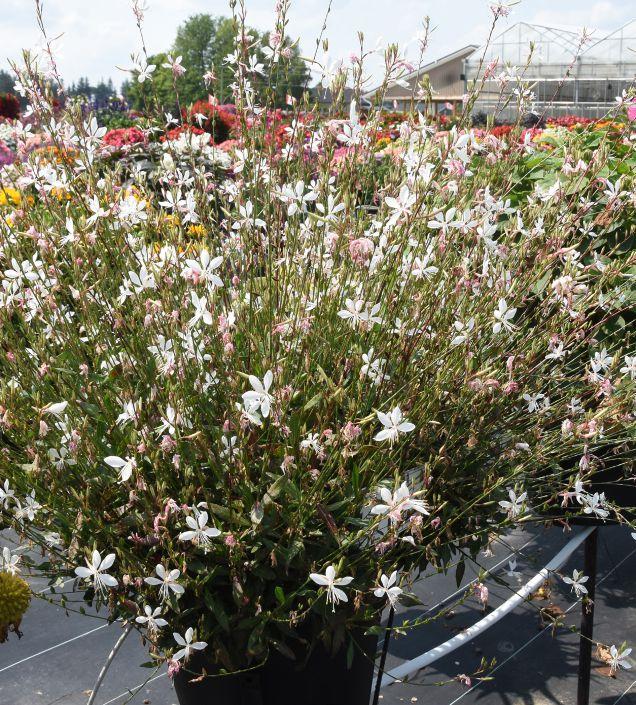
16. Gallardia Mesa Bright Bicolor 9/9
This Gallardia flowers early in the spring and features non-fading colours that attract birds and pollinators. It is a heat-tolerant, well-branched plant that is a powerful addition to landscapes.
17. Heliopsis helianthoides Touch of Blush 8/9
A perennial hardy in zones 4-9, Touch of Blush features semi-double yellow flowers with multiple overlapping petals that bloom the whole summer, and it is powdery mildew resistant. Great for landscape or large containers.
18. Lagerstroemia Barista Dark Roast 8/8
This plant boasts a dark foliage with red undertones and bright fuchsia flowers. It features a compact growth habit, and it flowers on new growth in our areas. It is a soft perennial for zone 5.
19. Stokesia Totally Stoked Riptide 9/9
This cultivar features periwinkle blue flowers all summer long. It is drought tolerant, and attracts bees and butterflies, but is deer and rabbit resistant. This stokesia is hardy to zones 5 to 9. It is one of few plants with this blue colour. I love growing in large containers then planting it in the garden mid-September, to enjoy the next season.
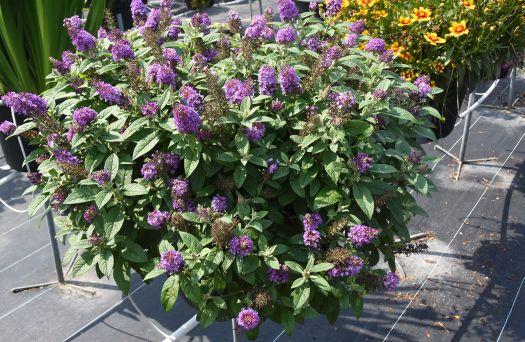
20. Gaura Sparkle White 9/9
These have been a favourite for the last 10 years because of the flowers that flow with the wind that makes any pot or landscape impressive to see the whole summer. No deadheading is necessary and its many tiny flowers attract humming birds.
Gaura thrives in rainy and hot weather. For a grower to be successful the plant must be mature enough to have impulse impact.
21. Buddleia Chrysalis Blue 10/10
Buddleia Chrysalis Blue is compact compared to other varieties. Butterflies cannot resist its extremely attractive blooms all summer long. It features a tight growth habit and has been a favourite perennial in our garden centre sales.

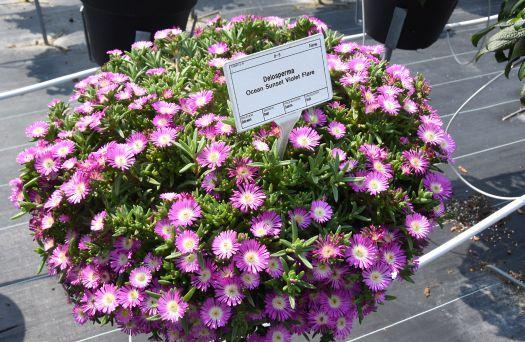
22. Delosperma Ocean Sunset Violet Flare 9/9
This is a perennial hardy for zones 5 to 9, with a high count of large flowers on a great cascading habit that is very drought tolerant and ideal for borders and rock gardens. My favourite is in large pots.
As always, I like to remind growers to try new-to-you varieties on a small scale. If the outcome is positive, in terms of growing and sales, then incorporate into your program.
Next year, the 2025 Sawaya Garden Trials will be held on July 17. Once again, more than 3,000 cultivars will be put to the test. More details to come.
Melhem Sawaya is a greenhouse consultant and owner of Sawaya Gardens in Waterford, ON. He can be reached at mel@focusgreehousemanagement.com.

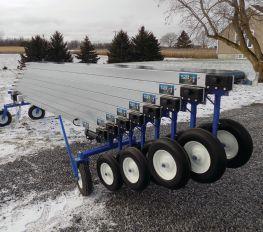


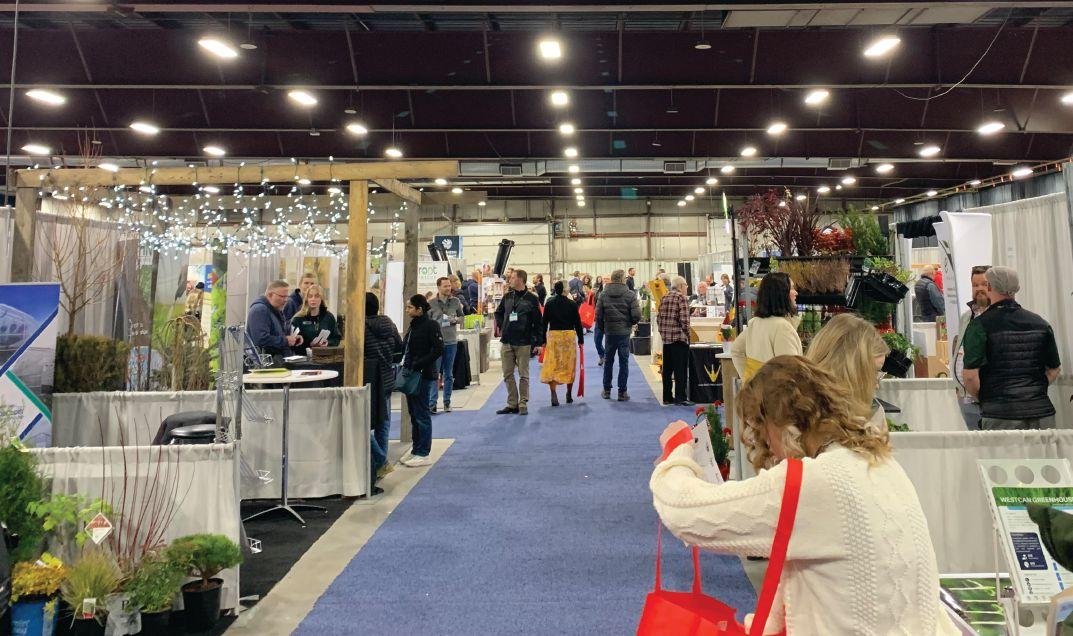
BY AMY KOUNIAKIS
In mid-November 2024, professionals from across the landscape and horticulture sectors converged on Red Deer, Alberta for the annual Green Industry Show and Conference, hosted by Landscape Alberta and the Alberta Greenhouse Growers’ Association.
Hundreds of attendees braved intense wintry conditions to attend “the largest industry trade show on the Prairies,” and to connect with colleagues, a testament to the event’s ever-increasing importance to the industry.
This year’s GISC featured a robust line-up of speakers and information sessions covering an array of subjects. Kicking things off on the first day was a rousing keynote from Jeff McManus, longtime Landscape Director at the University of Mississippi (Ole Miss) and published author, on cultivating and driving a culture of greatness. His passion for horticulture and creating usable, inviting, inclusive
ABOVE
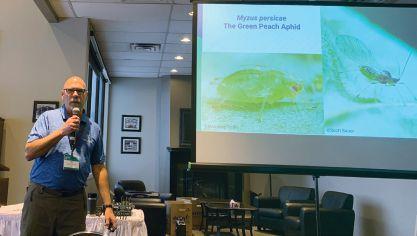
and safe spaces with minimal resources had the room abuzz with inspiration. His unique and enlightened insights on leadership and empowering those around him to embrace greatness provided much food for thought and discussion. It was a profound start to the 2024 GISC.
PanAmerican Seed’s Felicia Vandervelde helmed a session on post-COVID plant genetics that highlighted the work of breeders in trying to address grower and landscaper issues. Whether it’s in improving the downy mildew resistance in PanAm’s Beacon Impatiens, or the vigour and versatility of Benary’s lineup of Begonias, breeders are developing products with the Canadian marketplace top of mind. Vandervelde highlights Dümmen Orange’s True North Perennials have been tested for Canadian winters, as far north as Manitoba.
Ashleigh Munro (Kiwi Nurseries) and Jill
TOP: The tradeshow floor at the Green Industry Show and Conference in Red Deer, Alta. in November 2024. INSET: Olds College’s, Dr. Ken Fry, provides an update on controlling Thrips.




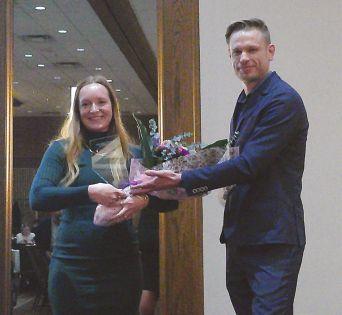

AGGA director, Simon Loewen (right) presents the Grower of the Year award to Chloe Veurink of Reuben’s Veggies (left) at the 2024 GISC.
Jeff McManus, longtime Landscape Director at the University of Mississippi (Ole Miss), spoke on leadership in his keynote at the 2024 GISC.
VanDuyvendyk (Dutch Growers Saskatoon) offered a glimpse at the garden centre through international eyes as they recapped their adventures from the International Garden Centre Association’s recent annual tour through garden centres in Quebec. They critiqued their retail experience at each destination and provided their notes on how it could’ve been improved. They shared some of the key takeaways from their experience and made suggestions geared towards the garden centre crowd looking to diversify. One of the more intriguing suggestions from the pair included creating a potting centre to encourage customers to buy a plant and pot it on the spot.

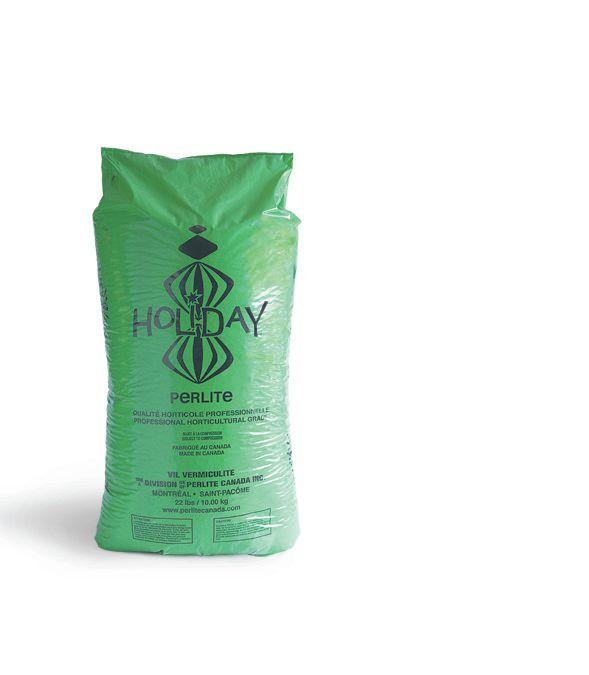
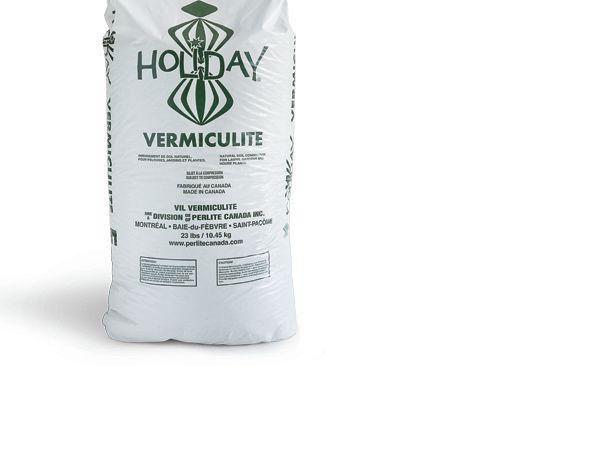
Later, on that first day, Greenhouse Canada was invited to sit in on the Alberta Greenhouse Growers’ Association’s AGM where this tight-knit group was updated on the state of the industry in the province. President Michiel Verheul spoke on how growers fared in light of water shortages, forest fires, increasing uncertainty surrounding energy and utilities, changes in the Federal seasonal workers program, and rumblings from our U.S. neighbour. He noted that despite these challenges, Alberta’s greenhouse sector reported a profitable year, and its water stewardship celebrated as the sector banded together to consult with provincial authorities on the efficient use of water. Verheul said the association is hard at work engaging with stakeholders on the energy front and keeping on top of changes to the seasonal workers’ program and advocating for growers. He ended his update by urging growers to keep engaged in these issues because “change is coming,” and the best way forward is for the sector across Canada to present a united front.
On that note, the meeting adjourned, and we filtered into a nearby ballroom for the annual AGGA Garden Party where the Alberta greenhouse industry lets down its hair and celebrates growers and their accomplishments over a delicious meal and awards ceremony. Verheul, bedecked in his signature black sequin dinner jacket, emceed the evening.
To kick-off the awards portion of the evening, Julie Doef was announced as the recipient of the Dr. Mirza Scholarship Award, which grants $1,000 to family of an AGGA member attending post-secondary school. This year’s Meritorious Services Award was handed out to Valerie Stobbe of Landscape Alberta, and Dietrich Kuhlmann of Kuhlmann’s Greenhouse in Edmonton, was the recipient of the prestigious Herb Knodel Award for outstanding service. Alberta’s greenhouse growers also took time to celebrate their Grower of Year, Chloe Veurink of Ruben’s Veggies.
Day 2 of the GISC was even snowier than Day 1, but attendees turned out in droves to hear from Rayne Gibson, owner of Taproots Horticulture Consulting. In his keynote address, entitled ‘Passion is not leadership,’ Gibson shared a deeply personal and moving story to illustrate how passion, while an important driving force, is just a small contributing factor to effective leadership. Communication, empathy, trust and humility, Gibson insists, play a much bigger role in inspiring and leading people. It was an emotional and thought-provoking start to the last day of GISC.
Next up, Dr. Ken Fry from Olds College provided an update on controlling Aphids in the greenhouse. Fry got into the nitty gritty of aphid reproduction and life cycles and their potential impact on crop health. He provided much insight into biological control methods and how growers can be good hosts to their predatory insects. There was quite a buzz around this incredibly informative session and judging from the questions, Fry provided attendees with some actionable observations to take back to their greenhouse. (For those who were unable to attend, Dr. Fry’s work is featured on Page 14 of this issue of Greenhouse Canada.)
Capping off the GISC experience this year, was an eye-opening presentation on Breeding for Garden Centres from ThinkPlants’ Anik Graves. Graves, who is ThinkPlants’ Trial Manager, detailed the process breeders go through in terms of developing and selecting new plant genetics and improving on existing varieties. It is a lengthy and cumbersome process that means some varieties will have gone through years of trials and testing programs, and likely travelled tens of thousands of kilometres before it reached its retail destination. It was an intriguing behind-the-scenes look at a vital piece of the sector that is often overlooked and undervalued.
As the 2024 GISC wound down on
From
that second day, exhibitors and attendees mingled on the still-busy trade show floor, bidding fond farewells to colleagues and friends alike, with promises to catch-up again next year. Next year’s Green Industry Show and Conference is scheduled for November 19 -20, 2025.


Les Entreprises Pitre, one of Canada’s largest berry producers is teaming up with Novafruit, a Quebecbased nursery, specialized in the propagation of fruit plants, to develop a new site dedicated to the soilless cultivation of strawberry, raspberry and blackberry plants.
In a recent release, the companies announced that the new collaboration will help quadruple production capacity in the Upper Laurentians and will create more than 50 new jobs.
The development plan aligns with Novafruit’s goal to increase opportunities for advancing genetics through international hybridization programs. The new site will also focus on integrating new production techniques suited to soilless and sheltered cultivation.
“Novafruit’s goal has always been to lead the small fruit industry in adopting innovative production systems by offering producers a combination of new plant types and varieties,” said Simon Parent, founder and president, in the release.
“This collaboration consolidates the achievement of
this goal and will position Novafruit as a world-class company.”
The new site, located in the Upper Laurentians, will complement existing facilities. Located in a remote forested area, the nursery is isolated from other fruit production sites to reduce potential contamination sources and the presence of pathogens.
The infrastructure will be utilizing the northern conditions cold climate and high altitude and latitude to help improve the floral initiation and plant vigor.
“The fruit industry is undergoing profound transformation and will be called upon to evolve from in-ground cultivation to soilless cultivation to meet current challenges,” said Michel Pitre, president of Les Entreprises Pitre, in the release.
“We are convinced that more and more farmers will integrate this method into their business models, as has happened in Europe over the past 25 years. We are combining our expertise, networks, knowledge, and the strengths of our teams to advance the industry towards more resilient agriculture.” (Source: Novafruit)
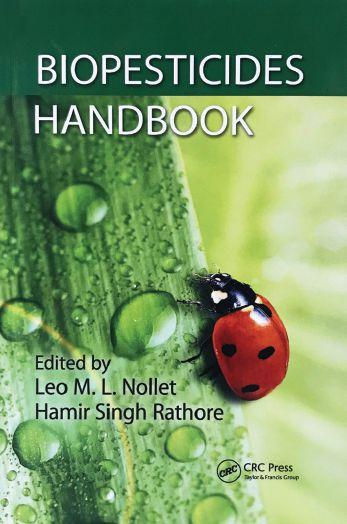

The need to feed an ever-growing global population combined with increasing demand for sustainable agricultural practices has generated a significant rise in demand for biopesticides. By responding concurrently to the interests of farming, forestry, and industrial sectors, biopesticides offer a considerable potential for utilization in sustainable agriculture. The BiopesticidesHandbook details the benefits of biopesticides all along the food chain, offering a full spectrum and review of the range of organisms and organic products that may be used in the biological control of insects.
February
GREENHOUSE BIOSECURITY WORKSHOP
Feb. 11-18
Zoom (Online)
LEAMINGTON GREENHOUSE GROWEREXPO
Feb. 12
Leamington, ON.
ONTARIO FRUIT AND VEGETABLE CONVENTION
Feb. 19 – 20
Niagara Falls, ON.
FRUIT AND VEGETABLE GROWERS OF CANADA ANNUAL GENERAL MEETING
March 11 - 13
Quebec City, Que.
INDOOR AG-CON
March 11 - 12
Las Vegas, NV.
OTTAWA VALLEY FARM SHOW
March 11 - 13
Ottawa, ON.
ACT LEAMINGTON GROWER SUMMIT 2025 March 19
Leamington, ON.
GREENTECH AMERICAS
March 25 - 27
Querétaro, Mexico
CALIFORNIA SPRING TRIALS
March 26 – 29
California, U.S.
April
CPMA CONVENTION AND TRADE SHOW
April 8 - 10
Montreal, Que.
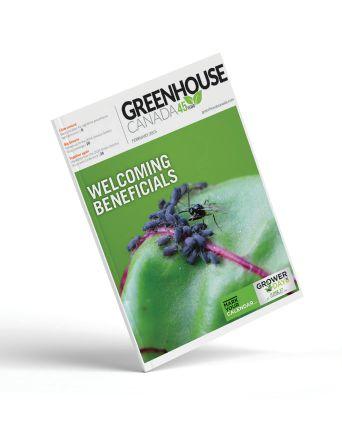

GARY JONES | greenhousewolf@gmail.com
Because of the way we’ve set up our worldwide plant distribution industry, many pests are now widespread, affecting various geographic regions, some bordering on ubiquitous worldwide. For example, Western Flower Thrips (WFT, Frankliniella occidentalis) is native to the Southwestern U.S., but partly because of the massive international trade in cut flowers and ornamentals cuttings, it has grown to become an invasive pest and vector of viruses in much of agriculture globally. Indeed, it is considered by many to be the number 1 insect pest worldwide, particularly in greenhouse crops. So, we need to pool our pest knowledge and understanding, and develop the most effective control strategies.
Which got me to wondering: ‘am I missing something in the way we do our strategic pest management planning?’
At continental level, we have academic meetings such as those organized by the International Organisation for Biological and Integrated Control (IOBC), which has six ‘regional’ groups. These are fabulous events, intent on sharing knowledge and experience. But my experience is that they are meetings of researchers, academics and commercial IPM companies/consultants, with very few grower
just pesticide priority setting; i.e. should there be ‘collaborative pest management planning’?
Recently, I came across an article: “US: Strategic plan laid out for South East pest protection”1, the essence of which is as follows:
“We need to pool our pest knowledge and understanding...”
practitioners attending. I also wonder (out of ignorance) if they really develop ‘coherent, strategic regional pest management plans’ or if they are just (but wonderful) platforms for information exchange?
Obviously, pest management options are developed at national level through government research and extension departments (e.g. through CFIA). These are vital sources of pest biology information, particularly when dealing with new pest species. But are they the best medium for developing regional management strategies?
At Provincial level, this information is distributed and applied through the Ministry of Agriculture and pest control companies. Again, a great source of knowledge, but this is primarily ‘top down’.
In B.C., for greenhouse vegetable crops, we have our annual ‘Minor Use Townhall’ meetings. These meetings involve government staff, biocontrol supply companies and distributors, and a small number of growers, and input is collated from Provincial to National level. But could there be more collaboration and strategy in developing control plans, rather than
The Pest Management Strategic Plan (PMSP) 2023 for Strawberries in VA, NC, SC, GA, and FL was developed by “twenty growers, University Extension Specialists, industry representatives, and USDA’s Office of Pest Management Policy plant pathologists”1“In January 2024, thirty-eight additional growers, University Extension Specialists, and industry representatives met in Savannah, GA, to collect the PMSP data related to South Carolina, Georgia, and Florida. This (2025) PMSP for strawberry production in the southeast of the U.S. was developed with the pooled data from these two workshop sessions.”1 “These workshop sessions aimed to develop a comprehensive list of pests, biological control agents, and chemical and cultural control tactics used in the region.”1 Priorities identified include Regulatory, Research, and Education. “Grower participation was vital to developing this document With their contributions, we are presenting the current challenges and needs of the strawberry industry in the southeast region of the U.S.”1 Perhaps I’m not aware of it, but I don’t know of such grower/researcher/ extension-inclusive workshops that take place in Canada to develop strategic pest management plans for specific crop disciplines. Yes, there are committees that collect information and pass it ‘up the chain’. But perhaps we should develop these workshops like those mentioned above, to build such crop specific pest management plans with a local/regional focus. Update them annually, or whenever there is an important new pest/disease to be considered, a new biocontrol or chemical option available, or a failure in one or more of our existing control options. What do you think? Does this system already exist? If not, how should we go about setting it up? Who should be the lead to drive this? How could it be funded? Hmm. Lots of questions. Which is fine, and I’ll leave them with you, if you don’t mind.
1. Source NC State Extension, reported in HortiDaily. com, Thur 2 Jan 2025
Gary Jones sits on several greenhouse industry committees in BC and welcomes comments at greenhousewolf@gmail.com.
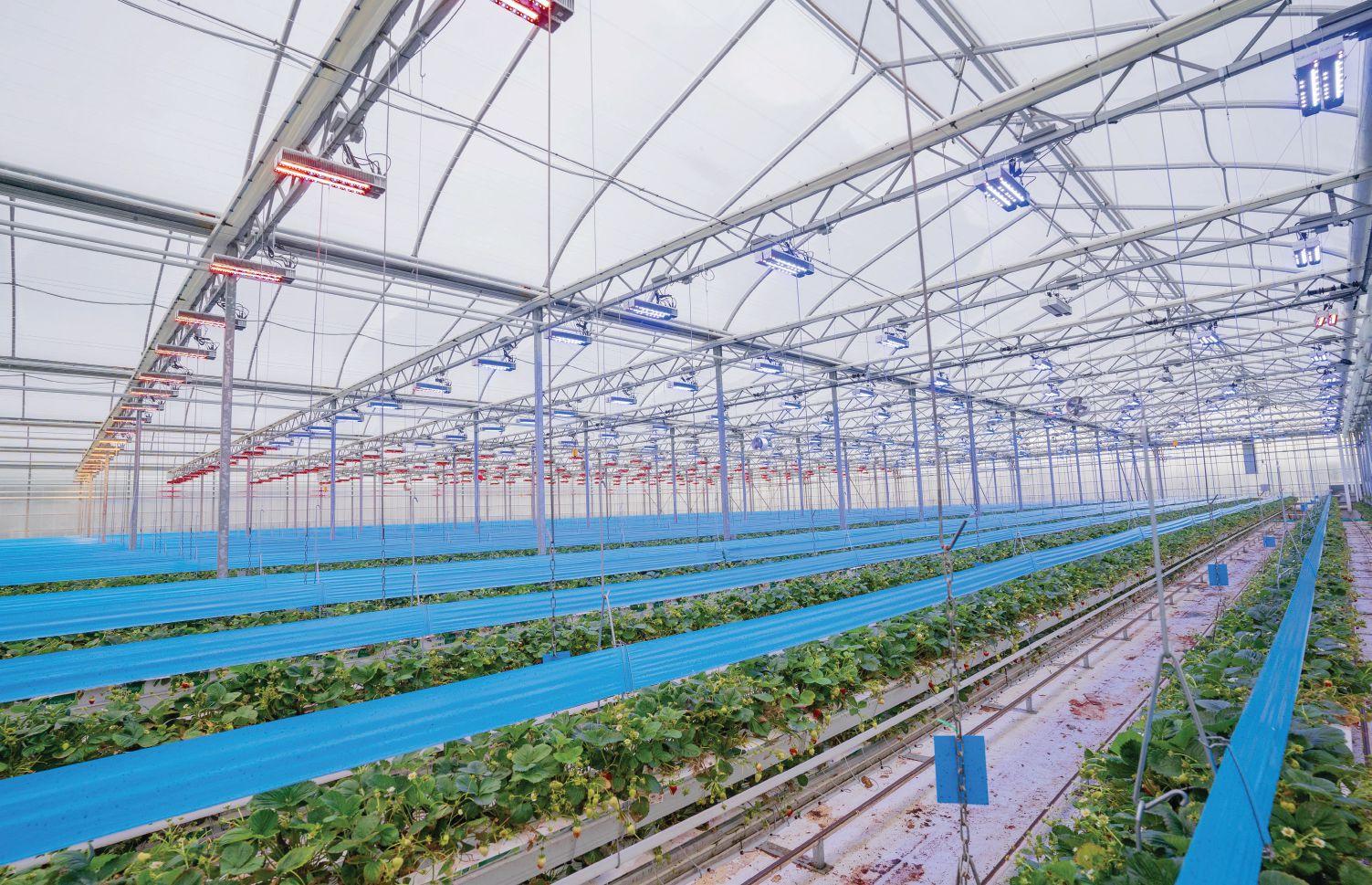
Is your lighting system working as hard as you?

It's important to evaluate the costs and benefits of every system in your greenhouse, and even more so with your LED lighting system.
So how does this apply to Sollum's fully dynamic LED lighting solution?
Sollum’s dynamic LED lighting solution is built to deliver measurable results, tailored to your crops. Growers have seen yield increases of 22%* for strawberries, 16% for mini cucumbers, and 137% for eggplants. Every recipe is personalized to match your goals—because your success is our priority.
Adaptability isn’t a luxury—it’s a necessity. With Sollum’s SUN as a Service (SUNaaS®) platform, switch crops effortlessly, adjust zones to grow multiple varieties, and refine light settings as your needs evolve. No extra fixtures, no extra costs—just a solution designed to grow with you.
Looking to optimize your lighting system?
Electricity is one of the largest expenses for greenhouses. That’s why efficiency matters. LEDs are already about twice as efficient as HPS lighting, but Sollum takes it a step further. Our dynamic LED solution automatically adjusts brightness in real time to match ambient light, delivering up to 40% energy savings compared to HPS.
On top of that, it’s up to 16.8% more efficient than standard LEDs, bringing total energy savings to an impressive 56.8%. And with certification from the DesignLights Consortium® (DLC)—an independent third-party testing organization —you can trust Sollum to deliver industry-leading efficiency.
Sollum’s LED fixtures last up to 80% longer than HPS, offering durability you can count on. Add energy savings and rebate programs, and your investment becomes a long-term advantage.
Your time is valuable, and Sollum makes sure you stay focused on what matters. With 24/7 expert support and real-time control through the SUNaaS dashboard, you have all the tools to grow smarter. You can even choose the level of support you need.
John Adams at:

Our plants are grown using a combination of the latest greenhouse technologies and IPM methods. Most of our liners are easy to transplant Elle Plugs, while others are traditional loose fill plugs or mesh sleeved Growcoons. The type of plug used is based upon the specific needs of the plant. Your Source for Top Quality Greenhouse Liners

